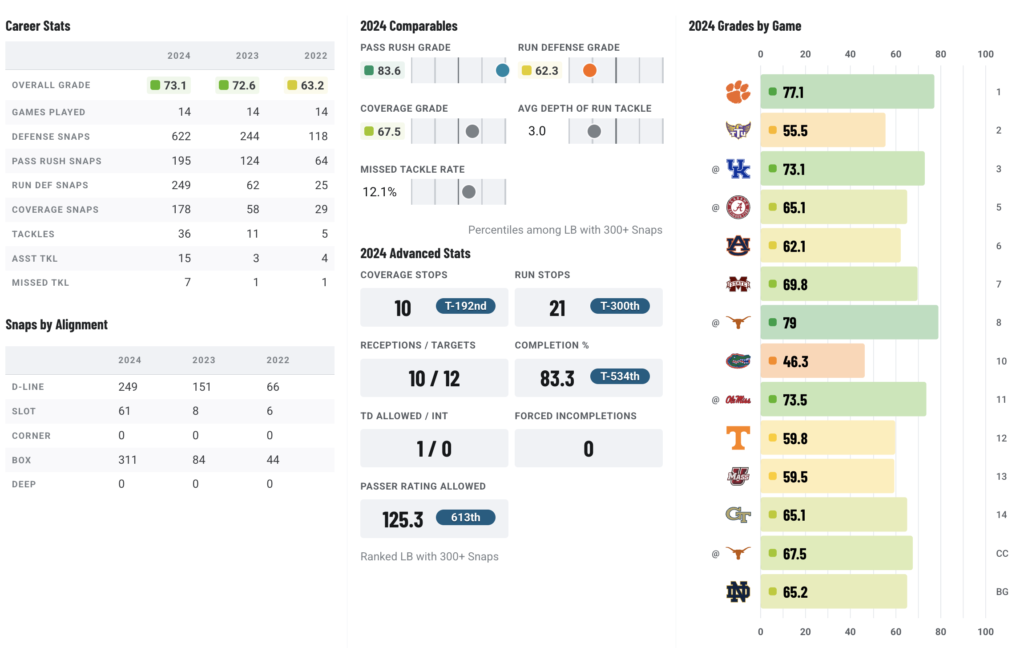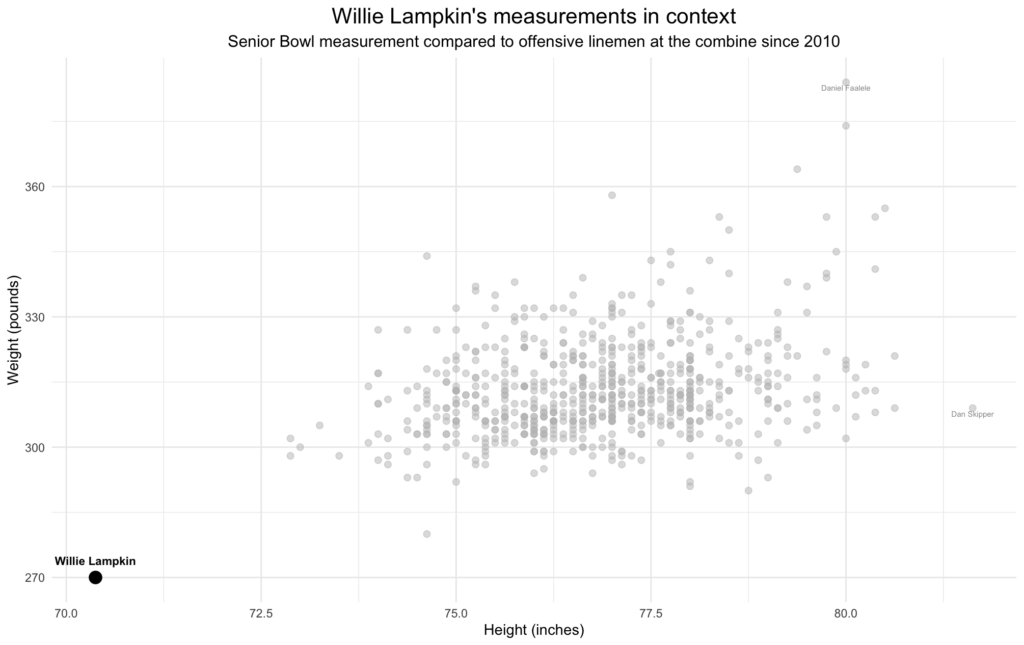- Shedeur Sanders has elite accuracy but must improve pocket discipline: Sanders' 81.8% adjusted completion rate is elite, but a nation-leading 17 QB-fault sacks in 2024 might raise a red flag.
- Shemar Stewart’s sack totals don’t tell the full story: The 267-pound edge dominated against the run and showed rare explosiveness despite limited pass-rush opportunities.
- 2025 NFL Draft season is here: Try PFF's best-in-class Mock Draft Simulator and learn about 2025's top prospects while trading and drafting for your favorite NFL team.
Estimated reading time: 10 minutes
As NFL teams wrap up pro days, host top-30 visits and finalize their draft boards, internal debates about risk versus upside will soon be reaching their climax. Weighing college production, athletic testing, physical tools and mental makeup, front offices are zeroing in on the prospects they’re most willing to take a leap of faith on.
Some teams favor safer, more stable evaluations, while others may be drawn to raw potential — where the reward outweighs the risk. Current Buffalo Bills quarterback Josh Allen is the poster child for this approach — the draft community widely criticized Allen for his inaccuracy in the lead-up to the 2018 NFL Draft, yet the Bills believed in his elite tools enough to trade up and take him at No. 7.
While there are just as many cautionary tales as success stories, it’s that uncertainty — and the potential for greatness — that makes the draft one of the most captivating events in sports despite the absence of an actual game.
In this piece, I’ll spotlight five of the 2025 class’s most hotly debated prospects — players some view as “boom or bust.” While opinions may vary, even within PFF, I believe each of these five is worth the gamble. With the right vision and creativity, their unique skill sets could translate into a major impact at the next level.

QB Shedeur Sanders, Colorado
Frankly, most quarterbacks fall under the “boom-or-bust” label simply by nature of the position, but Shedeur Sanders feels especially fitting given the polarized takes on his draft stock. In this week’s mock draft, I sent Sanders to Cleveland with the No. 2 overall pick, yet since the combine, some have speculated he could fall out of the first round entirely.
Accuracy and decision-making — two pillars of high-level quarterback play — give Sanders a real shot at becoming a franchise starter. His 81.8% adjusted completion rate ranked second in the country behind only Oregon’s Dillon Gabriel (81.9%), and Sanders’ average depth of target was 1.1 yards longer, meaning his throws were not only accurate but more challenging on average. Despite ranking fifth nationally with 481 pass attempts, he threw just eight turnover-worthy passes — good for a 1.3% turnover-worthy play rate, the third-lowest in the country.
For comparison, Cam Ward, the current favorite to go No. 1 overall to the Titans, posted a turnover-worthy throw rate of 3.3%, which ranked 49th.
Sanders' accuracy is supported by his ability to drive the ball when necessary and layer throws between levels against zone coverage. While many top prospects enter the league with only a fastball, Sanders arrives with the changeup already in his arsenal.
As for personality traits, I’m not overly concerned. Each team will have to determine whether he fits their culture, but in my view, Sanders is somewhat a victim of his last name when it comes to perception. This summer marks my 10-year anniversary at PFF, and in that “decade of decadence,” I’ve yet to find a reliable way to quantify personality traits.

One thing I can quantify — and something I do find concerning — is quarterback-owned pressures. When we chart pressures during a game, we don’t simply blame the nearest offensive lineman. Some pressures result from miscommunications on stunts or defensive schemes that overwhelm the protection. But when a quarterback holds the ball too long, drifts in the pocket or moves into pressure, we charge that pressure to the quarterback.
In 2024, Sanders led all quarterbacks in quarterback-fault sacks (17) and total pressures (44). His 2023 numbers weren’t much better — 13 sacks (tied for fourth-most) and 39 total pressures (tied with Caleb Williams for the most in the country). For comparison, this was a key issue in Williams’ rookie season in Chicago: he ranked third in the NFL with 38 quarterback-fault pressures in 2024 and led the league with 17 quarterback-fault sacks.
Quarterback-owned pressures speak directly to pocket presence and decision-making — two traits that, if uncorrected, can derail a season.
Both sides of the Sanders debate have compelling arguments, but if I’m the Browns and he’s on the board at No. 2, I’m pulling the trigger. There are no guarantees at the top of the draft — especially for a roster as talented as Cleveland’s — but Sanders brings traits worth betting on. While his pedigree doesn’t show up in blazing speed or a rocket arm, it’s evident in his preparation and how he processes defenses snap to snap. At times, he’s leaned too heavily on hero ball and created pressure for himself, but if he can become more consistent with his drop and footwork — and learn to take a zero when the play isn’t there — I believe Sanders has the tools to lead this team.
EDGE Shemar Stewart, Texas A&M
My shoulder is getting sore from constantly carrying the water for Stewart over here at PFF, but I’m a firm believer in his upside. He turned heads at the combine with a 4.59 40-yard dash, a 40-inch vertical and a 10-foot-11 broad jump, all while measuring in at 6-foot-5 and 267 pounds. That kind of standout athleticism should come as a surprise for those who’ve watched him on tape, as his burst and agility are evident throughout his film. His 88.2 run-defense grade in 2024 ranked fifth among all edge defenders, with only Marshall’s Mike Green posting a higher mark (90.2) among projected first-rounders.
Now, the pass-rushing production — or lack thereof — is certainly a concern. Stewart posted just an 11.8% win rate in 2024 and recorded only two sacks. But context matters. After removing plays affected by quick game, play-action and double-team blocks, Stewart logged just 106 true pass sets last season, ranking 74th in the draft class. For comparison, Boston College’s Donovan Ezeiruaku recorded 14 sacks but did so across 196 true pass sets. That gap helps explain why Stewart’s counting stats don’t jump off the page.
When I watch Stewart’s frame, athleticism, and backside effort on film, I see shades of Calais Campbell. And when I consider his elite run-defense grades paired with lower sack totals, I’m reminded of Danielle Hunter coming out of LSU. Both players have gone on to have long, productive NFL careers — and I’m betting Stewart will follow a similar path.
EDGE Jalon Walker, Georgia
Walker is an exciting athlete to watch, but he carries some risk because the skill driving his top-10 buzz — his pass-rushing ability — is something he hasn’t done full time.
Listed as an off-ball linebacker at Georgia, he logged 171 coverage snaps in 2024, nearly matching his 174 pass-rush reps. His performance in coverage and run defense was serviceable but unspectacular: he allowed 10 receptions on 12 targets, allowing a 125.3 passer rating on throws into his coverage. And he graded positively on just 12.9% of run-defense snaps, while earning negative grades on 13.7%.

Walker’s athleticism was most evident when rushing the passer, where he notched 28 total pressures and posted a 17.2% win rate in 2024. His all-around production brings to mind Micah Parsons’ rookie season with the Cowboys, when they initially split his time between off-ball linebacker and pass rusher before ultimately committing to him as a full-time edge defender.
Walker’s size is certainly a concern, as he measured 6-foot-1, 243 pounds at the combine with 32-inch arms. Those dimensions likely mean he’ll need to play off the line of scrimmage on early downs, but his athleticism is undeniable. His aggressiveness and quickness at the point of attack should allow him to shed blocks and create disruption in the backfield. He could hear his name called in the top 10, and I believe his athletic profile is worth the gamble for a team willing to get creative with how they deploy him.
CB Darien Porter, Iowa State
Darien Porter is one of the most unique players in this draft class. A six-year redshirt senior, he played just 724 scrimmage snaps over his college career and only began playing cornerback in 2022 — after spending high school and his first three seasons at Iowa State as a wide receiver. While he logged 965 special teams snaps during his time in Ames, he didn’t see significant action on defense until the 2024 season.
Unsurprisingly, the coverage sample size was small, but the production was outstanding. In 2024, Porter was targeted 17 times and allowed just five receptions for 70 yards. He intercepted three passes, dropped a fourth interceptable pass and broke up four more. While it’s a limited data set, the results speak for themselves: opposing quarterbacks posted a passer rating of just 4.7 when throwing his way.
His run defense, however, left much to be desired. Across 218 run-defense snaps, Porter recorded just seven tackles, missed four, and consistently struggled to shed blocks and maintain edge containment.
There’s no question Porter is a project, and at 24 years old, that can be a tough sell for teams. Still, his athleticism and ball skills present legitimate upside. At the combine, he ran a blazing 4.30 40-yard dash and posted a 6.71 three-cone drill—elite numbers for a 6-foot-3, 195-pound corner. Given his age and limited experience, he’s almost certain to be a Day 3 selection, but he fits the mold of an early fourth-round swing on a high-upside developmental player.
OL Willie Lampkin, North Carolina
At 5-foot-10, 270 pounds with 32-inch arms (per his Senior Bowl measurements), Willie Lampkin doesn't come close to typical NFL offensive line size. But the moment you turn on the tape, that concern quickly fades. He plays with relentless physicality at the line of scrimmage and uses his natural leverage to drive defenders off the ball. In 2024, he earned an 87.6 run-blocking grade — the highest among Power Four draft prospects — and an 88.8 pass-blocking grade, allowing no sacks and just four hits all season.

Will this level of production translate directly to the NFL? At his size, probably not—but that doesn’t mean he lacks a role at the next level. Teams that lean on heavy personnel in short-yardage situations could benefit from deploying him as an extra lineman or in-line tight end, and he could even be utilized as a fullback or H-back. While he doesn’t have special teams experience in college, his skill set could potentially provide value in that phase as well.
Lampkin did not receive an invite to the combine—a signal that he’s not expected to be drafted. However, I believe a team willing to get creative with his usage could get more blocking value from him than it would from a traditional third tight end or extra lineman. He may not fit the mold, but he absolutely warrants a late-round selection.



 © 2025 PFF - all rights reserved.
© 2025 PFF - all rights reserved.